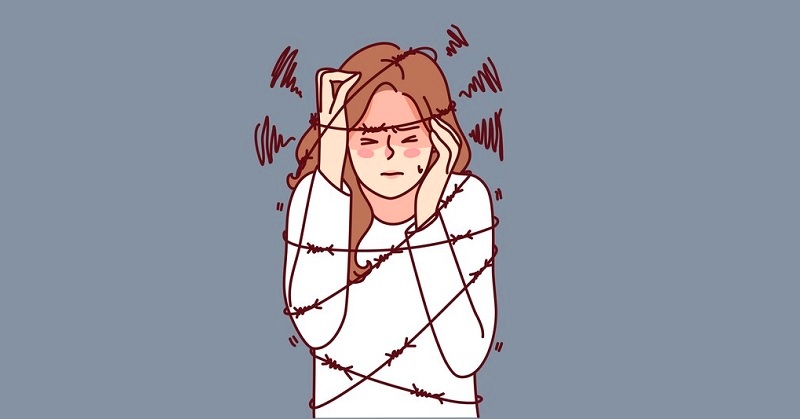The process of recovery isn’t linear. Sometimes you’ll do well, and sometimes you won’t.
Recovery from self-harm is no different. The act of self-harming causes and reinforces that method of coping with whatever may be going on in a person’s mind. The feeling of self-harm can even be addictive, besides the habit of using it as an unhealthy coping skill.
However, it’s not a healthy coping mechanism. It won’t help you recover and only causes more problems as time goes on.
If you’re trying to get back on track after a relapse with self-harm, we’ll give you some tips that can help you. But before we do that, let us just say:
It’s okay if you relapse. No matter what someone is trying to heal and recover from, most people relapse at some time or another. It’s totally normal and to be expected. No one can be perfect 100% of the time.
That being said, what should you do if you experience a self-harm relapse?
1. Reach out for professional help.
Do speak to a therapist or psychiatrist about your self-harm. They should be able to help you identify the trigger that caused you to relapse back into the habit, then help you develop some new coping skills.
You may be concerned that you will be forced to be in-patient. That is unlikely unless you express active intent to harm yourself again. This may differ from place to place, so you’ll want to familiarize yourself with the policies of the area you live in.
Most professionals or facilities will give you a pamphlet when you first start seeing them (or when you ask for one) that will outline their procedures so you can be aware. If you don’t have one, you can ask your professional or even the receptionist, and they should be able to give you one.
You may want to try speaking to a therapist via BetterHelp.com for online sessions you can have at a time and place that suits you. It’s not for everyone. Some people might prefer face-to-face counseling, but, similarly, some people might find online therapy easier and more convenient.
2. Look into online or offline support groups.
A support group can be an invaluable resource for emotional support while working on your self-harm habit.
The reality is that most people in your regular life aren’t going to understand. They can’t understand unless they’ve gone through it themselves. But even if they have gone through it themselves, they may not have gone through it for reasons similar to yours. Perhaps you inflict physical injuries or other forms of harm upon yourself due to trauma and subsequent PTSD, specific mental health issues, to cope with stress or other pain, or to counter the numbness of depression.
One of the benefits of support groups is that you can connect with people from all walks of life who might have had experiences just like yours.
3. Create a safety plan.
A safety plan is a pre-made outline of how you will handle particular triggers or problems that pop up.
So, for example, what can you do if you feel the urge to self-harm? Do you reach out to your professionals? Do you engage in other activities to pull your mind away from that urge? Do you go to a support group? Do you reach out to a loved one? Do you snap a rubber band on your wrist or hold ice cubes to simulate the act without damaging yourself?
There’s a good chance your safety plan will include many things. Consult with a professional to help develop a plan that makes sense for you.
4. Distract yourself from the feelings.
The more you focus on a particular feeling, the more strength you give it. Loneliness, fear, anger, shame, guilt, worthlessness, helplessness, hopelessness, self-blame, self-hatred – these all become amplified the more you focus on them.
Distraction is another way to try to lower the impact of depression, anxiety, and other mental health challenges and avoid behavior that is detrimental to you. Do things that make you feel good that will take your mind off that urge. Do things like watch a funny show, exercise, do a puzzle—anything that will help occupy your mind and take your thoughts off the difficult emotions.
5. Express your feelings differently.
Many people self-harm as a means to cope with the overwhelming feelings that they are having. That might be the intense emptiness of depression where a person self-harms to feel something. It could also be that you feel bad or guilty about doing something and feel that you must be punished. Whatever emotions you’re feeling, they’re likely intense and overwhelming.
Can you think of any other way that works for you to get those feelings out? Maybe you can create art, write, sing and cry your heart out to sad or loud music, or journal it out.
Now, understand that these kinds of activities are not likely to match the intensity that you’re used to with self-harm. The idea is to take some of the intensity out of your feelings so that you can maintain control over your actions.
6. Be kind to yourself.
Should you have relapsed, please don’t spend time beating yourself up. People with mental health challenges often struggle to be kind to themselves due to whatever challenges they face. Part of that struggle is to prevent yourself from tearing yourself down mentally when it happens.
By tearing yourself down and focusing on tearing yourself down, you may end up putting yourself in a spiral that further aggravates and worsens the relapse, possibly leading to self-destructive behavior of other types too.
It’s okay that you relapsed. Every time your mind wants to take you into that dark place and tell you that you can’t do this, remind yourself that everyone relapses, and it’s okay. You can try again. It’s not the end of your wellness journey.
7. It’s time to set a new goal.
Okay, you relapsed in your self-harm, and you’re trying to figure out how to move forward. One thing you can do is to set a new goal to be clean for one more day than your previous run.
Clean of self-harm for 90 days? Let’s make it 91 this time! But hey, I didn’t make it to 91 this time. What’s wrong with me? Why can’t I do this? I only went for 30 days this time. There’s nothing wrong with your current wellness path. Remember, it’s not a straight line. Sometimes you’ll do great; sometimes you’ll struggle. In that example, your next goal is 31 days. Get back on the path and start walking again.
Just because you relapse does not mean the journey is over. It does not mean you have to fall back into the hole and into bad habits. Instead, it means it’s time to shore yourself up with appropriate help. That might be talking to your mental health professionals. If you feel you may harm yourself again, consider going in-patient so they can help you get through it.
You can be better. You can recover. A relapse is not the end of the world. Your mental health professionals will understand that relapses happen. Support groups will understand that relapses happen. Your family, friends, and support network will hopefully understand if you are fortunate enough to have one.
You don’t need to go through it alone. In fact, it’d probably help your recovery if you had some people you could lean on while trying to get back on track. You fall down, get back up, and try again. You’ll get there. You just have to keep trying.
Again, if you aren’t already working with a professional and think that online therapy might be something you’d like to try, you can connect with an accredited and experienced therapist using BetterHelp.com to get the help you need.











